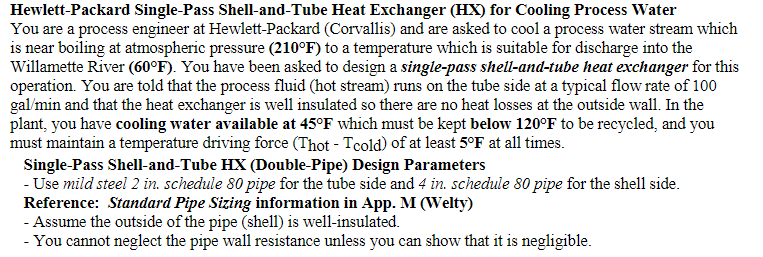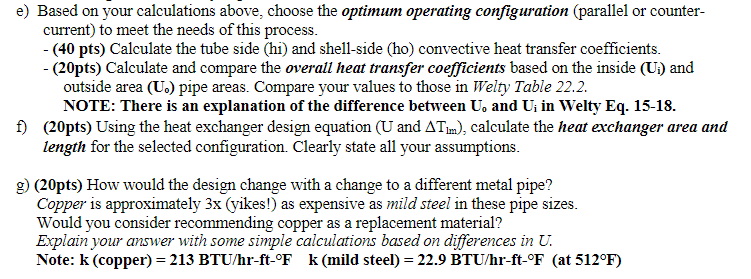

Hewlett-Packard Single-Pass Shell-and-Tube Heat Exchanger (HX) for Cooling Process Water You are a process engineer at Hewlett-Packard (Corvallis) and are asked to cool a process water stream which is near boiling at atmospheric pressure (210F) to a temperature which is suitable for discharge into the Willamette River (60F). You have been asked to design a single-pass shell-and-tube heat exchanger for this operation. You are told that the process fluid (hot stream) runs on the tube side at a typical flow rate of 100 gal/min and that the heat exchanger is well insulated so there are no heat losses at the outside wall. In the plant, you have cooling water available at 45F which must be kept below 120F to be recycled, and you must maintain a temperature driving force (Thot - Tcold ) of at least 5F at all times. Single-Pass Shell-and-Tube HX (Double-Pipe) Design Parameters - Use mild steel 2 in. schedule 80 pipe for the tube side and 4 in. schedule 80 pipe for the shell side. Reference: Standard Pipe Sizing information in App. M (Welty) - Assume the outside of the pipe (shell) is well-insulated. - You cannot neglect the pipe wall resistance unless you can show that it is negligible. e) Based on your calculations above, choose the optimum operating configuration (parallel or countercurrent) to meet the needs of this process. - (40 pts) Calculate the tube side (hi) and shell-side (ho) convective heat transfer coefficients. - (20pts) Calculate and compare the overall heat transfer coefficients based on the inside (Ui) and outside area (U0) pipe areas. Compare your values to those in Welty Table 22.2. NOTE: There is an explanation of the difference between U0 and Ui in Welty Eq. 15-18. f) (20pts) Using the heat exchanger design equation ( U and Tlm ), calculate the heat exchanger area and length for the selected configuration. Clearly state all your assumptions. g) (20pts) How would the design change with a change to a different metal pipe? Copper is approximately 3x (yikes!) as expensive as mild steel in these pipe sizes. Would you consider recommending copper as a replacement material? Explain your answer with some simple calculations based on differences in U. Note: k( copper) =213BTU/hrftFk (mild steel) =22.9BTU/hrftF (at 512F )








